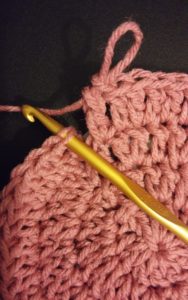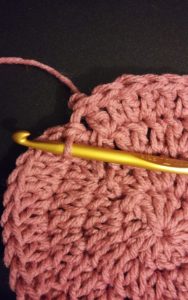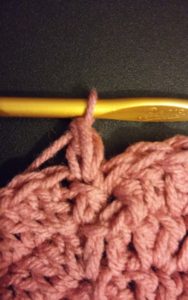 The more I play in crochet, the more I realize there really are no rules.
The more I play in crochet, the more I realize there really are no rules.
It seems that with colder weather finally descending on my community, everyone wants to crochet hats; most of them first time crocheters. So, as of late I have been teaching how to start circles, all three different ways. I have been teaching how to increase stitches. I have been teaching how to join rounds.
An interesting thing with joining rounds, there are a couple of ways to do it, and it can give you some different results. The method that I have been playing with lately does not actually involve a stitch at all.
When you get to the point of joining, the hook is removed from the working loop and inserted into the point of the join, the working loop is then slipped back on the hook and pulled through the point of join. This creates a join that has no extra yarn, no extra loops, and does not necessarily flatten out the stitch that is joined to as can happen with joining to a beginning chain.
If this is not enough, I added in a chainless starting stitch. So anytime you begin a new round or when working flat and turning your work, you usually chain a certain number of stitches to equate to the height of the stitches that are being worked. This is because all crochet stitches end at the top of the stitch, and thus the stitches next to it need to be of a similar height or it just pulls the stitches down. When beginning a new round the working loop is at the base poof the new stitches, and if no beginning chain is worked it can pull the stitch over and distort it. However, to get to this height of stitches, you do not necessarily need a chain.
Sometimes this is called a standing stitch, essentially all it is, is a long loop. After pulling the loop through the joining point, pull it up nice and tall, then work a double crochet (or whichever stitch you may be working) in the same stitch. You can even work the long loop among the stitch making it even less visible.
There are always pros and cons to various techniques, and with these two I find that the join can create a slight distortion, but in a different manner then the slip stitch; also it is a little slower to work and when I am crocheting along mindlessly it definitely stops my rhythm. One of the things I really like about this join is that it closes any gaps that might be created in my stitch placements at the joining point.
With the standing join, it is nice that everything looks pretty uniform, and there is no beginning chain that looks different than the rest of the stitches, yet there are times that the long loop can get a little distorted and uneven for me, I guess I need to work on getting a more even tension with it.
I guess with crochet there is always more to discover.



